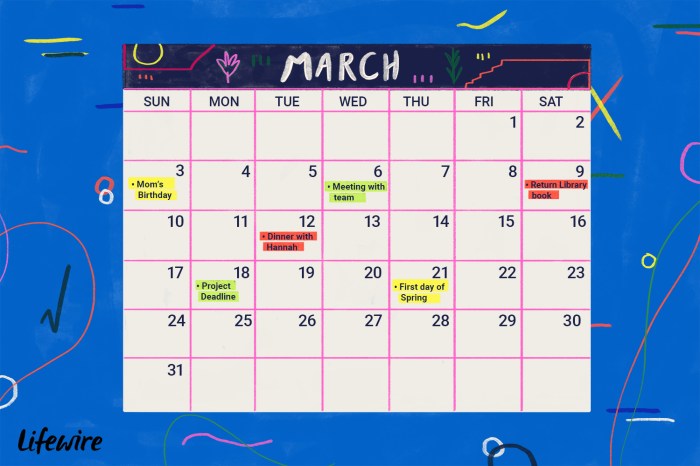Virtual calendar planners are revolutionizing how we schedule and manage our time. From simple appointments to complex project timelines, these digital tools offer unparalleled flexibility and efficiency. Gone are the days of cluttered paper calendars and missed deadlines. This comprehensive guide dives deep into the world of virtual calendar planning, exploring everything from core features and benefits to user experience, integration, and future trends.
This exploration will highlight the key features that set virtual calendar planners apart from traditional methods, emphasizing their user-friendly design and seamless integration with other productivity tools. We’ll analyze the various types of virtual calendar planners, comparing their functionalities and advantages to help you choose the right one for your needs. Ultimately, this guide empowers you to harness the power of virtual calendars for improved scheduling, enhanced collaboration, and greater productivity.
Virtual Calendar Planners: A Comprehensive Overview
Virtual calendar planners have revolutionized scheduling and time management, offering a powerful alternative to traditional paper calendars. These digital tools streamline organization, enhance collaboration, and integrate seamlessly with other productivity apps. This article explores the key aspects of virtual calendar planners, from their core functionalities to their integration with other applications and future trends.
Defining Virtual Calendar Planners

Virtual calendar planners are digital tools designed for scheduling appointments, managing tasks, and organizing events. They provide a centralized platform for managing personal and professional schedules, enabling users to visualize their commitments and deadlines. These tools range from stand-alone applications to integrated platforms that seamlessly connect with other productivity software.
- Stand-alone apps offer a focused approach to calendar management, often with unique features and designs. They typically function independently and do not require integration with other software.
- Integrated platforms often encompass a suite of productivity tools, including calendars, task managers, and project management systems. This integration streamlines workflows and provides a holistic view of work and personal activities.
The benefits of stand-alone apps include a highly focused experience, often with a unique aesthetic. Integrated platforms, however, provide the convenience of a unified workflow. The drawbacks of stand-alone apps might be the lack of seamless integration with other tools, while integrated platforms could potentially have slower loading times or less customization.
- Common Functionalities: Most virtual calendar planners share core functionalities, including scheduling appointments, setting reminders, creating recurring events, and sharing calendars with others.
- Additional Features: Advanced features often include task management, integration with email clients, and the ability to collaborate on schedules with team members.
Features and Benefits
User-friendly interfaces, intuitive navigation, and customizable features are crucial to the success of virtual calendar planners. These tools provide significant advantages over traditional paper calendars, including enhanced scheduling and time management capabilities.
- Enhanced Scheduling: Digital calendars facilitate precise scheduling, allowing users to block out time slots and prevent overlapping appointments. Reminders and alerts ensure adherence to scheduled events.
- Improved Time Management: Virtual planners enable efficient time management by allowing users to track their commitments, prioritize tasks, and allocate time effectively. This visibility enhances productivity.
- Integration with Other Tools: Many virtual planners integrate with email, task management applications, and project management software, streamlining workflows and creating a unified platform for managing work and personal life.
- Collaboration and Communication: Shared calendars foster better collaboration by enabling multiple users to view and manage shared schedules. This feature enhances communication and coordination within teams and groups.
| Feature | Google Calendar | Outlook Calendar | Fantastical |
|---|---|---|---|
| User Interface | Simple and intuitive | Robust and feature-rich | Clean and minimalist |
| Integration | Excellent integration with Google Workspace | Strong integration with Microsoft 365 | Strong mobile focus |
| Pricing | Free | Part of Microsoft 365 | Subscription-based |
User Experience and Design
A well-designed virtual calendar planner should prioritize intuitive navigation and clear visual cues. Personalization options enhance the user experience, catering to individual preferences and workflows.
- Navigation: Clear navigation menus, easily accessible features, and visual hierarchies are essential for smooth navigation within the calendar.
- Visual Cues: Effective use of color, font sizes, and visual cues (e.g., highlighting, bolding) helps users quickly understand and manage their schedule.
- Personalization: The ability to customize views, colors, and preferences ensures that the calendar reflects individual work styles and preferences.
| UI Element | Description |
|---|---|
| Calendar View | Displays events and appointments on a daily, weekly, or monthly basis. |
| Task List | Shows tasks associated with specific events or projects. |
| Event Details | Provides detailed information about each event, including time, location, attendees, and descriptions. |



